Abstract
Circular RNA (circRNA) is a type of non-coding RNA generated from back-splicing the reactions of linear RNA. It plays an important role in various cellular and biological processes. However, there are few studies about the regulatory effect of circRNAs on cashmere fiber traits in cashmere goats. In this study, the expression profiles of circRNAs in skin tissue were compared between Liaoning cashmere (LC) goats and Ziwuling black (ZB) goats, with a significant difference in cashmere fiber yield, cashmere fiber diameter, and cashmere fiber color, using RNA-seq. A total of 11,613 circRNAs were expressed in the caprine skin tissue, and their type, chromosomal distribution, and length distribution were characterized. A total of 115 up-regulated circRNAs and 146 down-regulated circRNAs in LC goats were screened compared to ZB goats. The authenticity of 10 differentially expressed circRNAs was validated by detecting their expression levels and the head-to-tail splice junction using RT-PCR and DNA sequencing, respectively. The parent genes of differentially expressed circRNA were mainly enriched in some Gene Ontology (GO) terms and pathways related to cashmere fiber traits, such as the canonical Wnt signaling pathway, which is involved in the regulation of cell promotion, stem cell proliferation, Wnt signaling pathway regulation, epithelial morphogenesis, MAPK signaling pathway, and cell adhesion molecules pathway. Eight differentially expressed circRNAs were further selected to construct a circRNA-miRNA network, and some miRNAs that were previously reported as related to fiber traits were found in the network. This study provides a deep understanding of the roles of circRNAs in the regulation of cashmere fiber traits in cashmere goats and the involvement of differential splicing in phenotypic expression according to breed and region.
1. Introduction
Circular RNA (circRNA) is a novel type of non-coding RNA that has attracted extensive attention in recent years. As there is a covalent closed-loop structure, circRNA is more stable and conservative than its parent linear RNA [1]. It has been confirmed that most circRNAs mainly act as microRNA (miRNA) sponges to relieve the inhibition of the target mRNAs in expression derived from miRNAs [2]. These circRNAs also play a biological function in increasing the expression levels of the target genes. Alternatively, some circRNAs can interact with RNA-binding proteins to regulate the expression of their parent genes by regulating the transcription of RNA polymerase II or modifying the methylation of N6-methyladenosine (m6A) [3,4]. Additionally, a small number of circRNAs have the ability to translate into functional proteins [5]. In this context, it can be reasonably suggested that circRNAs can become powerful tools for accurately elucidating the biological mechanisms underlying complex economic traits in domestic animals.
Skin is one of the largest organs and can produce wool or cashmere fibers in sheep or goats. In cashmere goats, the fleece is composed of cashmere and larger-fiber-diameter “guard hairs”, which are produced by the secondary fiber follicles and the primary fiber follicles, respectively. It is well known that the structure of the skin tissue and hair follicle development determine the yield and quality of cashmere fibers. Many studies have found that circRNAs play roles in a variety of biological processes in organisms, including the regulation of the growth and development of skin and hair follicles in cashmere goats. For example, circRNA-1967, circRNA-1926, and circRNA-0100 exhibited significantly higher expression at anagen than at telogen in secondary hair follicles of cashmere goats. Moreover, the three circRNAs regulated the expression levels of LEF1, CDK19, and KLF5 by competitively binding miR-93-3p, miR-148a/b-3p, and miR-153-3p, respectively, eventually promoting the differentiation of secondary hair follicle stem cells into a hair follicle lineage in cashmere goats [6,7,8].
Additionally, in recent years, RNA-seq has been widely used to construct expression profiles of circRNAs and investigate their roles in the skin tissue of cashmere goats and sheep. For example, a total of 32 differentially expressed circRNAs were identified in skin tissue between two cashmere goat breeds with divergent cashmere fiber traits [9]. Similarly, another study found 32 differentially expressed circRNAs in the skin tissue between Liaoning cashmere goats and Inner Mongolia cashmere goats, and their parent genes were significantly enriched in keratinization, intermediate filament organization, spindle midzone, Wnt-protein binding, Wnt-activated receptor activity, and the negative regulation of stress fiber assembly, which were related to the formation and growth of cashmere fiber [10].
Liaoning cashmere (LC) goats and Ziwuling black (ZB) goats are famous dual-purpose breeds for cashmere fiber and meat in China, and the two breeds are also of economic importance in the regions in which they are raised. There are significant differences in cashmere production performance and quality between LC goats and ZB goats. Namely, the cashmere fiber diameter of ZB goats is smaller than that of LC goats, but LC goats have a higher cashmere yield than ZB goats. Meanwhile, LC goats produce white cashmere fibers, while ZB goats produce purple cashmere fibers. However, the biological mechanism that regulates the differences remains unclear. Accordingly, in this study, RNA-seq was used to profile the circRNA expression of caprine skin tissue. The differentially expressed circRNAs were also identified between LC goats and ZB goats, and their parent genes were used to perform a functional enrichment analysis. A circRNA-miRNA was constructed to screen for functional circRNAs acting as miRNA sponges. The results will uncover the molecular mechanisms underlying the differences in cashmere fiber traits between LC and ZB goats and reveal potential functions of circRNAs in the regulation of cashmere fiber traits in goats.
2. Materials and Methods
2.1. Ethics Statement
All animal experiments involved in this study were approved by the Animal Experimental Ethics Committee of Gansu Agricultural University with the approval number of GSAU-ETH-AST-2021-028.
2.2. Sample Collection
At the Yunfeng Cashmere Goat Breeding Company (Huan county, Qingyang, China), six healthy, three-year-old male LC goats and six healthy, three-year-old male ZB goats were selected for investigation. All goats were used for cashmere fiber production and raised under the same feeding management level. The cashmere fiber weight and cashmere fiber diameter of the LC goats selected in the study were 1539 ± 26.6 g and 15.9 ± 0.07 μm, while the ZB goats were 395 ± 17.5 g and 13.9 ± 0.03 μm, respectively.
In mid-August, when these goats were in the anagen phase of cashmere fiber growth, the skin sample for each goat was collected using a surgical biopsy. Briefly, the wool on the surface of the skin was shaved and then wiped with 75% alcohol. After local anesthesia, about 3 cm2 of skin on the right side of each goat was grasped with sterile pliers and quickly cut off with a sterile scalpel. The goats were immediately treated with Yunnan Baiyao (Yunnan Baiyao Group Co., Ltd., Kunming, China) to stop the bleeding. The skin samples collected were washed with physiological saline and RNase water and then cut into small pieces measuring 1 cm × 2 cm. The samples were quickly frozen in liquid nitrogen.
2.3. RNA Extraction and Sequencing
Total RNA was isolated and purified from twelve caprine skin tissue samples using Trizol reagent (Invitrogen, Carlsbad, CA, USA). The purity and concentration of the RNA extracted were checked using a Nanodrop 2000 (Thermo Scientific, Waltham, MA, USA) and a Qubit® 2.0 fluorometer (Life Technologies, Carlsbad, CA, USA), respectively. The RNA integrity number (RIN) measured by an Agilent 2100 Bioanalyzer (Agilent, Palo Alto, CA, USA) was used to screen high-quality RNA samples (RIN > 7). Ribosomal RNA (rRNA) was depleted from these high-quality RNA samples using a Ribo-Zero Gold rRNA Removal Kit (Illumina, San Diego, CA, USA), and the remaining RNA was used to produce complementary DNA (cDNA) libraries using a NEBNext Ultra RNA Library Prep Kit (New England Biolabs, Ipswich, MA, USA). The cDNA libraries constructed were paired-end sequenced using an Illumina HiSeq2500 sequencer (Illumina, San Diego, CA, USA) at the Gene Denovo Biotechnology Co., Ltd. (Guangzhou, China).
2.4. RNA-Seq Data Analysis
For raw reads obtained in the FASTQ format, their unqualified reads were removed to obtain clean reads, including adapter reads, reads containing poly (A) bases, low-quality reads with quality scores < Q20, and reads containing more than 10% of unknown nucleotides. The clean reads were mapped against Caprine Genome Assembly ARS1.2 (https://www.ncbi.nlm.nih.gov/assembly/GCF_001704415.2, accessed on 27 June 2020) using HISAT2 v2.1.0. For the reads that were unmapped against Caprine Genome Assembly ARS1, 20 bp from both ends were intercepted as anchor reads. The anchor reads were aligned to the reference genome again using bowtie2 v2.2.8 and the alignment results were used to identify circRNAs using Find_circ [11]. The characteristics of the circRNAs identified were analyzed by counting their length, type, and chromosome distribution.
The expression levels of the annotated circRNAs were normalized with the Reads Per Million mapped reads (RPM). The parameters of fold change > 2.0 and p < 0.05 were set as the threshold to screen differentially expressed circRNAs in skin tissue between LC goats and ZB goats using the DESeq v2.0.
2.5. Validation of the Authenticity of circRNAs Using RT-PCR and Sanger Sequencing
The authenticity of the circRNAs annotated in the study was verified using reverse transcriptase-PCR (RT-PCR) and DNA sequencing. Briefly, a total of 10 differentially expressed circRNAs were selected. The 12 RNA samples that were used for RNA-seq were also used to produce cDNA using an Evo M-MLV RT mix kit (Accurate Biology, Changsha, Hunan, China). In addition, the cDNA was amplified using divergent primers (Table 1). The RT-PCR products were detected by 1.5% agarose gel electrophoresis and then sequenced using Sanger sequencing. To validate the presence of the head-to-tail splice junction of circRNAs, the sequences obtained from Sanger sequencing were aligned to sequences from RNA-seq and Caprine Genome Assembly ARS1.2 using MEGA 5.0.

Table 1.
PCR primer used to amplify circRNAs.
2.6. Validation of the Reliability of RNA-Seq by RT-qPCR
To confirm the reliability of the RNA-seq results, the same 10 differentially expressed circRNAs that were analyzed using RT-PCR were selected to perform RT-quantitative PCR (RT-qPCR). The RNA samples originally extracted for the RNA-seq analysis were used to produce cDNA using an Evo M-MLV RT mix kit. The RT-qPCR was performed in triplicate using SYBR® Green PCR Master Mix (Takara, Dalian, China) on an Applied Biosystems QuantStudio® 6 Flex (Thermo Lifetech, Waltham, MA, USA). Caprine GAPDH was selected as an internal reference gene to normalize the expression levels of these circRNAs [12]. Their relative expression levels were calculated using the 2−ΔΔCt method.
2.7. GO and KEGG Enrichment Analysis of the Parent Genes of Differentially Expressed circRNAs
The functional enrichment of the parent genes of differentially expressed circRNAs was analyzed using the Gene Ontology database (http://www.geneontology.org/, accessed on 7 November 2020) and the Kyoto Encyclopedia of Genes and Genomes database (http://www.kegg.jp/kegg, accessed on 7 November 2020). The GO terms and KEGG pathways with p < 0.05 were considered significantly enriched based on a hypergeometric test.
2.8. Construction of circRNA-miRNA Regulatory Network
Eight differentially expressed circRNAs belonging to the annot_exons type were selected, and Mireap v0.2 (https://sourceforge.net/projects/mireap/, accessed on 23 May 2022), Miranda v3.3a, (http://www.microrna.org/microrna/home.do, accessed on 23 May, 2022) and targetscan v3.1 (http://www.targetscan.org/, accessed on 23 May, 2022) were used to predict the binding sites of the target miRNAs of the circRNAs. The predicted results overlapped. Of all the miRNAs predicted, the miRNAs related to hair follicle growth and development were chosen. A circRNA-miRNA regulatory network was constructed using starBase v3.0 and then visualized using Cytoscape v3.5.1.
3. Results
3.1. Identification and Characterization of circRNAs in Skin Tissue of Cashmere Goats
The raw reads obtained in this study have been submitted to the GenBank database with accession numbers SRR19879981-SRR19879992. After removing unqualified reads, a total of 84,025,004 and 92,946,813 clean reads were obtained in skin tissue collected from LC and ZB goats, respectively, of which 84,011,916 and 92,921,492 reads mapped well to the Caprine Genome Assembly, with a unique mapping rate of 93.46% and 92.41%, respectively. A total of 11,613 circRNAs were detected from the caprine skin tissue, with 7639 circRNAs being co-expressed in both breeds (Figure 1A). In other words, there were 9314 and 9938 circRNAs identified in the skin tissue of LC and ZB goats, respectively.
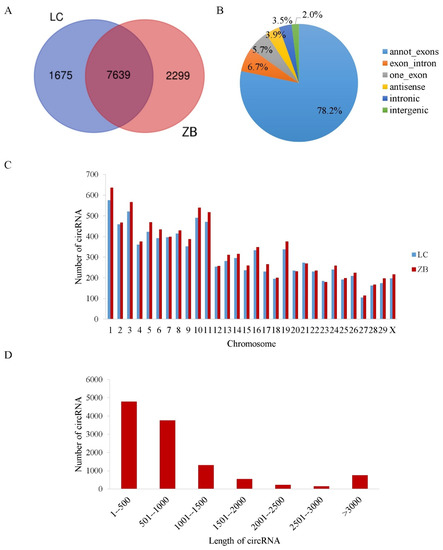
Figure 1.
General characteristics of circRNAs in the skin tissue of Liaoning cashmere (LC) goats and Ziwuling black (ZB) goats. (A) A Venn diagram showing the number of expressed circRNAs in the caprine skin tissue of LC goats and ZB goats. (B) The types of circRNAs in the caprine skin tissue. (C) The chromosomal distribution of circRNAs identified in the caprine skin tissue. (D) The length distribution of circRNAs in the caprine skin tissue.
Of the six types of circRNAs classified, annot_exons were the most common sequences, accounting for 78.2% of the total circRNAs identified. This was followed by exon_intron, one_exon, and antisense, with an average proportion of 6.7%, 5.7%, and 3.9%, respectively. Intronic and intergenic sequences were the least common types, with an average proportion of 3.5% and 2.0%, respectively (Figure 1B). The circRNAs found in the caprine skin tissues were distributed across all the caprine chromosomes, including the X chromosome. The most circRNAs were distributed on chromosomes 1, 3, 10, and 11, while the least circRNAs were distributed on chromosome 27 (Figure 1C). The majority of the circRNAs had a length of less than 1000 bp (Figure 1D).
3.2. Validation of the Authenticity of circRNAs Identified in the Caprine Skin Tissue
RT-PCR and Sanger sequencing were used to verify the authenticity of the circRNAs identified using an RNA-Seq analysis. The RT-PCR results found that all 10 circRNAs could be expressed, with an expected size band on agarose gel electrophoresis. The DNA sequencing results verified the presence of the head-to-tail splice junction sequences as suggested by RNA-Seq (Figure 2).
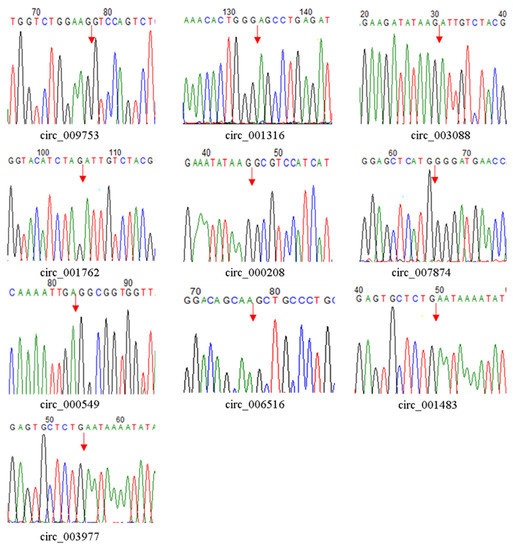
Figure 2.
Confirmation of the back-splicing junctions for 10 circRNAs selected using Sanger sequencing. A red arrow represents the junction site on the DNA sequence chromatograms.
3.3. Analysis and Validation of Differentially Expressed circRNAs between the Two Caprine Breeds
Of all the 11,613 circRNAs identified in caprine skin tissue, 261 circRNAs were found to be differentially expressed between LC and ZB goats, including 115 up-regulated circRNAs and 146 down-regulated circRNAs in the skin tissue of LC goats when compared to ZB goats (Supplementary File S1). The five most up-regulated circRNAs in LC goats were circ_003977, circ_001161, circ_004733, circ_003577, and circ_000549, while the five most down-regulated circRNAs in LC goats were circ_007344, circ_001762, circ_003528, circ_000831, and circ_008802. Notably, of the differentially expressed circRNAs detected, 50 circRNAs were only expressed in ZB goats, while 29 circRNAs were only expressed in LC goats.
To further validate the reliability of the RNA-seq data, the 10 differentially expressed circRNAs that were used to verify the authenticity described above were selected for RT-qPCR analysis. As shown in Figure 3, the relative expression levels of circ_000549, circ_006516, circ_001483, and circ_003977 in LC goats were higher than those in ZB goat skin tissue. However, the relative expression levels of circ_009753, circ_001316, circ_003088, circ_001762, circ_000208, and circ_007874 in the skin tissue of LC goats were lower than those in ZB goats. The results indicate that the RT-qPCR results of these circRNAs in caprine skin tissue were consistent with those obtained from RNA-seq, which further illustrated the reliability of the RNA-seq data (Figure 3).
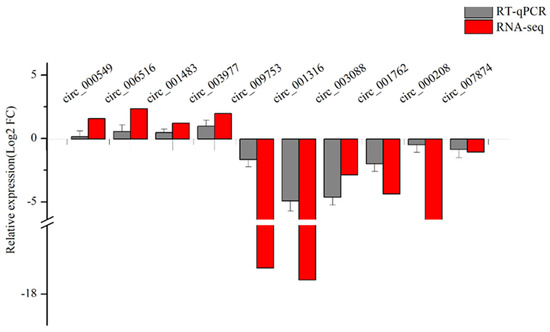
Figure 3.
The comparisons of the expression levels of 10 differentially expressed circRNAs obtained from RNA–seq with those obtained from RT–qPCR analysis.
3.4. Function Enrichment Analysis of the Parent Genes of Differentially Expressed circRNAs
In order to further explore how these differentially expressed circRNAs regulate differences in cashmere fiber traits between LC goats and ZB goats, GO and KEGG analyses were carried out for their parent genes. A total of 240 parent genes were annotated for the 261 differentially expressed circRNAs. The most significant GO term with the lowest p value was regulation of GTPase activity (p = 3.74 × 10−5), followed by ubiquitin-like protein transferase activity (p = 7.51 × 10−5), centrosome duplication (p = 0.0003), and mRNA metabolic process (p = 0.0006). It was notable that several important GO terms related to hair follicle growth were also found, including the canonical Wnt signaling pathway involved in the regulation of cell promotion (p = 0.0124), stem cell proliferation (p = 0.0033), Wnt signaling pathway regulation (p = 0.0275), and epithelial morphogenesis (p = 0.0370) (Figure 4A).
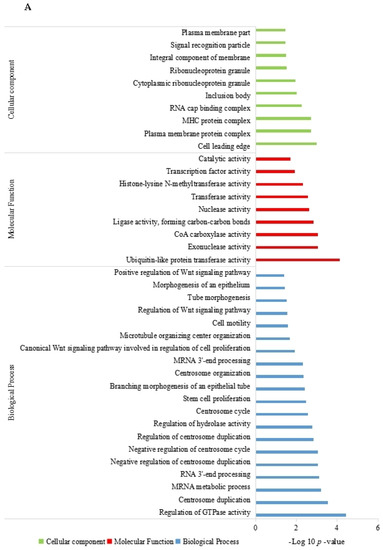
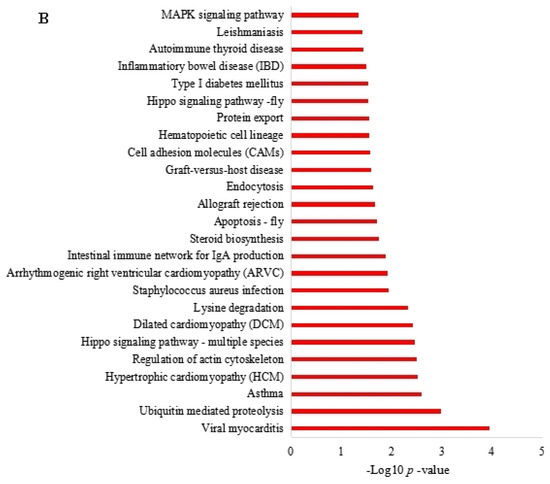
Figure 4.
Gene ontology (A) and KEGG enrichment (B) analysis of the parent genes of differentially expressed circRNAs.
The parent genes of the differentially expressed circRNAs were significantly enriched in 25 KEGG pathways. The most significant pathway with the lowest p value was viral myocarditis (p = 0.0001), followed by ubiquitin-mediated proteolysis (p = 0.0011), asthma (p = 0.0025), and hypertrophic cardiomyopathy (p = 0.0031) (Figure 4B). Interestingly, the MAPK signaling pathway and the cell adhesion molecules pathway associated with fiber traits were also enriched.
3.5. The miRNA Sponges Analysis of Differentially Expressed circRNAs
It is well known that annot_exons circRNAs located in the cytoplasm can function as miRNA sponges. To investigate potential miRNA sponge roles of circRNAs in caprine skin tissue, 8 differentially expressed annot_exons circRNAs were selected, including 6 up-regulated circRNAs (circ_003577, circ_001980, circ_007262, circ_005384, circ_004891, and circ_002284) and 2 down-regulated circRNAs (circ_003005 and circ_000353) in LC goats. Among them, circ_003577, circ_007262, and circ_001980 were expressed only in LC goats, while circ_000353 was expressed only in ZB goats. The 8 circRNAs have a total of 137 miRNA binding sites. Based on the roles of the miRNAs in hair follicle growth and development reported previously [4,13,14], 11 sponge miRNAs were further selected to construct a circRNA-miRNA network (Figure 5). As shown in Figure 5, 16 pairs of circRNA-miRNAs were screened.
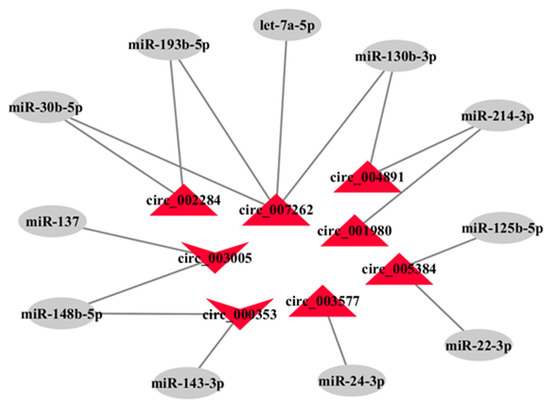
Figure 5.
The interaction network of circRNA-miRNA. The red triangles and inverted triangles indicate up-regulated and down-regulated circRNAs in the skin tissues of Liaoning cashmere (LC) goats compared to Ziwuling black (ZB) goats, respectively. The gray circles represent predicted target miRNAs for circRNA.
4. Discussion
As a high-quality textile material, cashmere fiber is produced from the secondary hair follicles of skin tissue in cashmere goats [15]. The secondary hair follicle development involves dynamic and cyclical periods of anagen, catagen, and telogen, and cashmere fibers therefore also show seasonal growth and shedding [16]. Previous studies have shown that the periodic activities of hair follicles regulate the growth of cashmere fiber. Either prolonging the anagen phase of secondary hair follicles or shortening their catagen and telogen phases can effectively increase cashmere fiber growth time, eventually leading to increases in cashmere yield [17,18]. In this context, it is of great significance to study the development of secondary hair follicles for the improvement of the yield and quality of cashmere fiber. Recent studies have found that non-coding RNAs have certain regulatory roles in hair follicle growth and development and cashmere fiber traits [19,20]. Therefore, the expression profile of circRNAs in skin tissue and their effect on cashmere traits and hair follicle development were investigated.
In this study, a total of 11,613 circRNAs were identified by RNA-seq in the skin tissue of LC and ZB goats during the anagen period. The number of circRNAs identified was similar to what was investigated by Zheng et al. [10], who found 13,320 circRNAs in the skin tissue of LC goats during the anagen period. However, the number of circRNAs expressed in the study was less than that reported in a previous study of skin tissue in Inner Mongolia cashmere goats at four different embryonic stages, with 21,784 circRNAs being identified [21]. This indicates breed-specific and time-specific expression patterns of circRNAs in goats, which is consistent with previous findings of circRNAs [22,23,24]. In this study, the differential expression of circRNAs also confirmed the breed-specific pattern, as 29 and 50 circRNAs were only expressed in the skin tissue of LC and ZB goats, respectively.
It was notable that 78.2% of the circRNAs identified were of the annot_exons type, which located in more than two exon regions of the coding genes. This indicates the preference of some protein-coding genes for loop formation [25]. This was also consistent with the results obtained from Inner Mongolian cashmere goats [21]. Meanwhile, caprine chromosome 1 produced the most circRNAs in this study. This was not surprising, as that chromosome is the largest in size when compared to other chromosomes in the goat genome. The study conducted by Shen et al. [24] in caprine longissimus dorsi muscle tissue also confirmed the result.
The up-regulated circ_006516 in LC goats attracted our attention as it had the highest expression level in LC goats. The circRNA is derived from KRT33A, also known as KIFⅠ. KIFⅠ is a member of the keratin intermediate filament family [26]. Keratin intermediate filament proteins are one of the main structural proteins of cashmere fibers and therefore determine the physico-mechanical characteristics of cashmere fiber [27]. As one of the down-regulated circRNAs in LC goats, circ_005116 is derived from KRT84. KRT84 encodes the type II of hair keratin in the fibrous cuticles that are assembled in a highly organized fashion into keratin intermediate filaments [28,29]. Variations in genes encoding keratin have been reported to be associated with cashmere fiber diameter and curvature [30,31]. It was notable that of the differentially expressed circRNAs identified in this study, circ_001980 was only expressed in the skin tissue of LC goats, while circ_009498 was only expressed in ZB goats. The parent genes of circ_001980 and circ_009498 are CDK19 and FGFR2, respectively. CDK19 and CDK8 have high amino acid conservation, so they are also called CDK8L. CDK8 was required for Wnt/β-catenin signaling activation, which is important for hair follicle generation, differentiation of hair follicle stem cells, and hair stem cell growth [8,32]. It is possible that circ_001980 and circ_009498 originated from CDK19, and FGFR2 may be involved in the regulation of the differences in cashmere fiber between LC and ZB goats. Taken together, it was therefore inferred that specifically expressed circ_001980 and circ_009498 in LC and ZB goats, respectively, may be responsible for the differences in cashmere fiber traits between LC goats and ZB goats.
In order to further explore the potential regulatory effect of circRNAs on cashmere fiber traits, GO and KEGG functional enrichment analyses were applied to their parent genes. Of the GO terms enriched by the parent genes, morphogenesis of an epithelium (GO:0002009), microtubule organizing center organization (GO:0031023), developmental growth involved in morphogenesis (GO:0060560), plasma membrane part (GO:0044459), regulation of Wnt signaling pathway (GO:0030111), and cell motility (GO:0048870) were involved in the development and formation of cashmere fibers. For example, Wnt signaling is the most critical pathway to induce hair follicle development [33]. Wnt signaling is also thought to be involved in the regulation of melatonin on hair follicle development. Melatonin has been found to promote cashmere fiber growth, eventually leading to increases in cashmere fiber yield [34,35,36]. Similarly, stem cell proliferation is closely related to the growth and development of hair follicles and the growth and formation of cashmere fiber. Proliferation and differentiation of hair follicle stem cells has been confirmed as an important condition for hair follicles to enter the growth stage and the main power source of hair regeneration [37,38]. Of the KEGG pathways enriched by the parent genes, the MAPK signaling pathway is an important pathway for the growth and development of mammalian hair follicles, as well as melanogenesis [39,40]. In addition, the parent genes of differentially expressed circRNAs identified in this study were also enriched in the cell adhesion molecule pathway. Cell adhesion molecules are proteins on the surface of cells that can bind to other cells or adhere to the extracellular matrix [41]. The extracellular matrix affects the quality of cashmere fiber by regulating the growth of hair follicles [42]. Therefore, it can be concluded that cell adhesion molecules also have certain effects on cashmere fiber quality. Taken together, the differentially expressed circRNAs found in the study may affect cashmere fiber traits by regulating the GO terms and KEGG pathways involved in their parent genes.
It has been confirmed that circRNA can regulate the expression level of the target genes by acting as a ‘sponge’ for miRNA. It was therefore important to investigate the interaction between specific circRNA and the sponge miRNA. In the study, some predicted target miRNAs of circRNAs have been reported to be involved in the regulation of cashmere fiber traits and hair follicle development. For example, as one of the most up-regulated circRNAs in LC goats, circ_003577 would target miR-24-3p (Figure 5). It has been found that miR-24-3p can change the structure of hair follicles in mice by inhibiting the expression of the hair keratinocyte stemness regulator Tcf-3, which causes a decreased cashmere fiber diameter [14]. This suggests that up-regulated circ_003577 may result in an increased cashmere fiber diameter of LC goats by decreasing the inhibited effect of miR-24-3p on cashmere fiber diameter. Furthermore, up-regulated circ_005384 in LC goats would target miR-22-3p and miR-125b-5p (Figure 5). The miR-22-3p targets STK40 to inhibit MEF2-ALP activity, which is beneficial to hair follicle stem cell differentiation and hair growth [13]. Similarly, miR-125b-5p was found to inhibit cashmere fiber growth as it inhibited the regeneration and transformation in the fiber growth cycle by targeting FGF5 and TNF-α [43]. It was speculated that up-regulated circ_005384 in LC goats may promote fiber growth, which leads to an increased cashmere fiber yield by sponging the inhibited effect of miR-125b-5p on cashmere fiber growth. Taken together, these results may explain why up-regulated circ_003577 and circ_005384 may produce a higher cashmere fiber yield and a larger diameter in LC goats.
It was notable that some miRNAs exhibited in the circRNA-miRNA interaction network were related to the cashmere fiber color. For example, circ_000353 was not only a down-regulated circRNA in LC goats but was also only expressed in the skin tissue of ZB goats. The circRNA would target miR-143-3p (Figure 5). It has been reported that miR-143-3p can reduce the production of melanin by suppressing the expression of TGF-β- activated kinase1 (TAK1) [44]. Down-regulated circ_000353 may therefore lead to white cashmere fiber in LC goats by lessening the inhibiting effect of miR-143-3p on melanosis. Similarly, miR-137 targeted by circ_003005 (Figure 5) inhibited the formation of melanin by negatively regulating the expression of c-KIT and TYRP2 in the SCF/c-Kit signaling pathway, thus participating in the regulation of the hair color of mice [45]. Similar to circ_000353, down-regulated circ_003005 may result in white cashmere fiber from LC goats by lessening the inhibiting effect of miR-137 on the formation of melanin. Taken together, these suggest that the differential expression of the circRNAs described above may be responsible for the difference in cashmere fiber color between LC and ZB goats by acting as miRNA sponges.
5. Conclusions
In this study, a total of 11,613 circRNAs were expressed in the caprine skin tissue. Among them, 261 circRNAs were differentially expressed in skin tissue between LC goats and ZB goats, with significant differences in cashmere fiber traits. As shown in Figure 6, differentially expressed circRNAs contributed to the regulation of hair follicle development and cashmere fiber traits through the involvement of their parent genes. A circRNA-miRNA network revealed that eight circRNAs play an important role in the regulation of cashmere fiber traits by acting as miRNA sponges. The results provide a solid foundation for further, in-depth investigations into the function of individual circRNA in the cashmere fiber traits of cashmere goats.
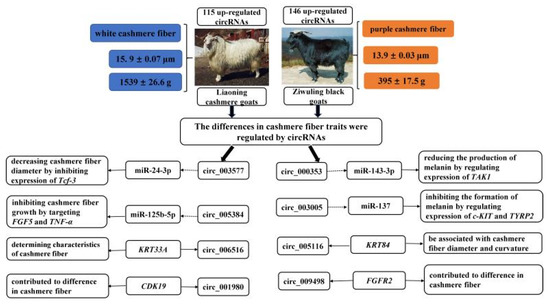
Figure 6.
The regulatory mechanism of circRNAs on differences in cashmere fiber traits between LC and ZB goats.
Supplementary Materials
The following supporting information can be downloaded at: https://www.mdpi.com/article/10.3390/genes14020331/s1, Supplementary File S1: The differentially expressed circRNAs identified in Liaoning cashmere (LC) goats compared to Ziwuling black (ZB) goats.
Author Contributions
L.H. and J.W. conducted data analysis and wrote the manuscript. Y.L., X.L., S.L. and Z.H. collected and processed samples. F.Z., M.L., B.S. and Y.G. conducted formal method analysis and software analysis. J.W. was responsible for project management and revised the manuscript. All authors have read and agreed to the published version of the manuscript.
Funding
This research was funded by the fund for Basic Research Creative Groups of Gansu Province (22JR5RA829), Discipline Team Project of Gansu Agricultural University (GAU-XKTD-2022-21), the Fuxi Young Talents Fund of Gansu Agricultural University (Gaufx-02Y02), the Science and Technology Project of Lanzhou City (2021-1-162), and Lanzhou City Overseas Expertise Introduction Base for Molecular Breeding of Mutton Sheep.
Institutional Review Board Statement
All animal experiments involved in this study were approved by the Animal Experimental Ethics Committee of Gansu Agricultural University with the approval number of GSAU-ETH-AST-2021-028.
Informed Consent Statement
Not applicable.
Data Availability Statement
The data presented in this study are available on request from the corresponding author.
Conflicts of Interest
There are no conflict of interest to declare.
References
- Jeck, W.R.; Sharpless, N.E. Detecting and characterizing circular RNAs. Nat. Biotechnol. 2014, 32, 453–461. [Google Scholar] [CrossRef]
- Salzman, J.; Gawad, C.; Wang, P.L.; Lacayo, N.; Brown, P.O. Circular RNAs are the predominant transcript isoform from hundreds of human genes in diverse cell types. PLoS ONE 2012, 7, e30733. [Google Scholar] [CrossRef] [PubMed]
- Zhang, Y.; Zhang, X.O.; Chen, T.; Xiang, J.F.; Yin, Q.F.; Xing, Y.H.; Zhu, S.; Yang, L.; Chen, L.L. Circular intronic long noncoding RNAs. Mol. Cell 2013, 51, 792–806. [Google Scholar] [CrossRef] [PubMed]
- Zhou, C.; Molinie, B.; Daneshvar, K.; Pondick, J.V.; Wang, J.; Van Wittenberghe, N.; Xing, Y.; Giallourakis, C.C.; Mullen, A.C. Genome-Wide Maps of m6A circRNAs Identify Widespread and Cell-Type-Specific Methylation Patterns that Are Distinct from mRNAs. Cell Rep. 2017, 20, 2262–2276. [Google Scholar] [CrossRef]
- Yang, Y.; Fan, X.; Mao, M.; Song, X.; Wu, P.; Zhang, Y.; Jin, Y.; Yang, Y.; Chen, L.L.; Wang, Y.; et al. Extensive translation of circular RNAs driven by N6-methyladenosine. Cell Res. 2017, 27, 626–641. [Google Scholar] [CrossRef]
- Zhu, Y.; Wang, Y.; Zhao, J.; Shen, J.; Wang, Z.; Bai, M.; Fan, Y.; Yin, R.; Mao, Y.; Bai, W. CircRNA-1967 participates in the differentiation of goat SHF-SCs into hair follicle lineage by sponging miR-93-3p to enhance LEF1 expression. Anim. Biotechnol. 2021, 22, 1–13. [Google Scholar] [CrossRef] [PubMed]
- Zhao, J.; Shen, J.; Wang, Z.; Bai, M.; Fan, Y.; Zhu, Y.; Bai, W. CircRNA-0100 positively regulates the differentiation of cashmere goat SHF-SCs into hair follicle lineage via sequestering miR-153-3p to heighten the KLF5 expression. Arch. Anim. Breed. 2022, 65, 55–67. [Google Scholar] [CrossRef]
- Yin, R.H.; Zhao, S.J.; Jiao, Q.; Wang, Z.Y.; Bai, M.; Fan, Y.X.; Zhu, Y.B.; Bai, W.L. CircRNA-1926 Promotes the Differentiation of Goat SHF Stem Cells into Hair Follicle Lineage by miR-148a/b-3p/CDK19 Axis. Animals 2020, 10, 1552. [Google Scholar] [CrossRef]
- Hui, T.; Zheng, Y.; Yue, C.; Wang, Y.; Bai, Z.; Sun, J.; Cai, W.; Zhang, X.; Bai, W.; Wang, Z. Screening of cashmere fineness-related genes and their ceRNA network construction in cashmere goats. Sci. Rep. 2021, 11, 21977. [Google Scholar] [CrossRef]
- Zheng, Y.; Hui, T.; Yue, C.; Sun, J.; Guo, D.; Guo, S.; Guo, S.; Li, B.; Wang, Z.; Bai, W. Comprehensive analysis of circRNAs from cashmere goat skin by next generation RNA sequencing (RNA-seq). Sci. Rep. 2020, 10, 516. [Google Scholar] [CrossRef]
- Memczak, S.; Jens, M.; Elefsinioti, A.; Torti, F.; Krueger, J.; Rybak, A.; Maier, L.; Mackowiak, S.D.; Gregersen, L.H.; Munschauer, M.; et al. Circular RNAs are a large class of animal RNAs with regulatory potency. Nature 2013, 495, 333–338. [Google Scholar] [CrossRef]
- Lv, X.; Chen, W.; Sun, W.; Hussain, Z.; Chen, L.; Wang, S.; Wang, J. Expression profile analysis to identify circular RNA expression signatures in hair follicle of Hu sheep lambskin. Genomics 2020, 112, 4454–4462. [Google Scholar] [CrossRef]
- Cai, B.; Li, M.; Zheng, Y.; Yin, Y.; Jin, F.; Li, X.; Dong, J.; Jiao, X.; Liu, X.; Zhang, K.; et al. EZH2-mediated inhibition of microRNA-22 promotes differentiation of hair follicle stem cells by elevating STK40 expression. Aging 2020, 12, 12726–12739. [Google Scholar] [CrossRef]
- Amelio, I.; Lena, A.M.; Bonanno, E.; Melino, G.; Candi, E. miR-24 affects hair follicle morphogenesis targeting Tcf-3. Cell Death Dis. 2013, 4, e922. [Google Scholar] [CrossRef] [PubMed]
- Zhang, Q.L.; Li, J.P.; Chen, Y.; Chang, Q.; Li, Y.M.; Yao, J.Y.; Jiang, H.Z.; Zhao, Z.H.; Guo, D. Growth and viability of Liaoning Cashmere goat hair follicles during the annual hair follicle cycle. Genet. Mol. Res. 2014, 13, 4433–4443. [Google Scholar] [CrossRef] [PubMed]
- Dai, B.; Liang, H.; Guo, D.D.; Bi, Z.W.; Yuan, J.L.; Jin, Y.; Huan, L.; Guo, X.D.; Cang, M.; Liu, D.J. The Overexpression of Tβ4 in the Hair Follicle Tissue of Alpas Cashmere Goats Increases Cashmere Yield and Promotes Hair Follicle Development. Animals 2019, 10, 75. [Google Scholar] [CrossRef]
- Bai, W.L.; Dang, Y.L.; Wang, J.J.; Yin, R.H.; Wang, Z.Y.; Zhu, Y.B.; Cong, Y.Y.; Xue, H.L.; Deng, L.; Guo, D.; et al. Molecular characterization, expression and methylation status analysis of BMP4 gene in skin tissue of Liaoning cashmere goat during hair follicle cycle. Genetica 2016, 144, 457–467. [Google Scholar] [CrossRef] [PubMed]
- Müller-Röver, S.; Handjiski, B.; van der Veen, C.; Eichmüller, S.; Foitzik, K.; McKay, I.A.; Stenn, K.S.; Paus, R. A comprehensive guide for the accurate classification of murine hair follicles in distinct hair cycle stages. J. Investig. Dermatol. 2001, 117, 3–15. [Google Scholar] [CrossRef]
- Yuan, C.; Wang, X.; Geng, R.; He, X.; Qu, L.; Chen, Y. Discovery of cashmere goat (Capra hircus) microRNAs in skin and hair follicles by Solexa sequencing. BMC Genom. 2013, 14, 511. [Google Scholar] [CrossRef]
- Wang, S.; Ge, W.; Luo, Z.; Guo, Y.; Jiao, B.; Qu, L.; Zhang, Z.; Wang, X. Integrated analysis of coding genes and non-coding RNAs during hair follicle cycle of cashmere goat (Capra hircus). BMC Genom. 2017, 18, 767. [Google Scholar] [CrossRef]
- Shang, F.; Wang, Y.; Ma, R.; Di, Z.; Wu, Z.; Hai, E.; Rong, Y.; Pan, J.; Liang, L.; Wang, Z.; et al. Expression Profiling and Functional Analysis of Circular RNAs in Inner Mongolian Cashmere Goat Hair Follicles. Front. Genet. 2021, 12, 678825. [Google Scholar] [CrossRef] [PubMed]
- Hao, Z.; Zhou, H.; Hickford, J.G.H.; Gong, H.; Wang, J.; Hu, J.; Liu, X.; Li, S.; Zhao, M.; Luo, Y. Identification and characterization of circular RNA in lactating mammary glands from two breeds of sheep with different milk production profiles using RNA-Seq. Genomics 2020, 112, 2186–2193. [Google Scholar] [CrossRef]
- Wang, J.; Zhou, H.; Hickford, J.G.H.; Hao, Z.; Gong, H.; Hu, J.; Liu, X.; Li, S.; Shen, J.; Ke, N.; et al. Identification and characterization of circular RNAs in mammary gland tissue from sheep at peak lactation and during the nonlactating period. J. Dairy Sci. 2021, 104, 2396–2409. [Google Scholar] [CrossRef] [PubMed]
- Shen, J.; Zhen, H.; Li, L.; Zhang, Y.; Wang, J.; Hu, J.; Liu, X.; Li, S.; Hao, Z.; Li, M.; et al. Identification and characterization of circular RNAs in Longissimus dorsi muscle tissue from two goat breeds using RNA-Seq. Mol. Genet. Genom. 2022, 297, 817–831. [Google Scholar] [CrossRef]
- Wilusz, J.E. A 360° view of circular RNAs: From biogenesis to functions. Wiley Interdiscip. Rev. RNA 2018, 9, e1478. [Google Scholar] [CrossRef]
- Coulombe, P.A.; Omary, M.B. ‘Hard’ and ‘Soft’ principles defining the structure, function and regulation of keratin intermediate filaments. Curr. Opin. Cell Biol. 2002, 14, 110–122. [Google Scholar] [CrossRef]
- Powell, B.C.; Rogers, G.E. The role of keratin proteins and their genes in the growth, structure and properties of hair. EXS 1997, 78, 59–148. [Google Scholar] [CrossRef] [PubMed]
- Yu, Z.; Wildermoth, J.E.; Wallace, O.A.; Gordon, S.W.; Maqbool, N.J.; Maclean, P.H.; Nixon, A.J.; Pearson, A.J. Annotation of sheep keratin intermediate filament genes and their patterns of expression. Exp. Dermatol. 2011, 20, 582–588. [Google Scholar] [CrossRef]
- Langbein, L.; Schweizer, J. Keratins of the human hair follicle. Int. Rev. Cytol. 2005, 243, 1–78. [Google Scholar] [CrossRef]
- Gao, Y.; Wang, X.; Yan, H.; Zeng, J.; Ma, S.; Niu, Y.; Zhou, G.; Jiang, Y.; Chen, Y. Comparative Transcriptome Analysis of Fetal Skin Reveals Key Genes Related to Hair Follicle Morphogenesis in Cashmere Goats. PLoS ONE 2016, 11, e0151118. [Google Scholar] [CrossRef]
- Yu, Z.; Gordon, S.W.; Nixon, A.J.; Bawden, C.S.; Rogers, M.A.; Wildermoth, J.E.; Maqbool, N.J.; Pearson, A.J. Expression patterns of keratin intermediate filament and keratin associated protein genes in wool follicles. Differentiation 2009, 77, 307–316. [Google Scholar] [CrossRef] [PubMed]
- Firestein, R.; Bass, A.J.; Kim, S.Y.; Dunn, I.F.; Silver, S.J.; Guney, I.; Freed, E.; Ligon, A.H.; Vena, N.; Ogino, S.; et al. CDK8 is a colorectal cancer oncogene that regulates beta-catenin activity. Nature 2008, 455, 547–551. [Google Scholar] [CrossRef]
- DasGupta, R.; Fuchs, E. Multiple roles for activated LEF/TCF transcription complexes during hair follicle development and differentiation. Development 1999, 126, 4557–4568. [Google Scholar] [CrossRef]
- Ge, W.; Wang, S.H.; Sun, B.; Zhang, Y.L.; Shen, W.; Khatib, H.; Wang, X. Melatonin promotes Cashmere goat (Capra hircus) secondary hair follicle growth: A view from integrated analysis of long non-coding and coding RNAs. Cell Cycle 2018, 17, 1255–1267. [Google Scholar] [CrossRef]
- Nixon, A.J.; Choy, V.J.; Parry, A.L.; Pearson, A.J. Fiber growth initiation in hair follicles of goats treated with melatonin. J. Exp. Zool. 1993, 267, 47–56. [Google Scholar] [CrossRef] [PubMed]
- Fischer, T.W.; Slominski, A.; Tobin, D.J.; Paus, R. Melatonin and the hair follicle. J. Pineal Res. 2008, 44, 1–15. [Google Scholar] [CrossRef] [PubMed]
- Greco, V.; Chen, T.; Rendl, M.; Schober, M.; Pasolli, H.A.; Stokes, N.; Dela Cruz-Racelis, J.; Fuchs, E. A two-step mechanism for stem cell activation during hair regeneration. Cell Stem Cell 2009, 4, 155–169. [Google Scholar] [CrossRef]
- Fernandes, K.J.; Kobayashi, N.R.; Gallagher, C.J.; Barnabé-Heider, F.; Aumont, A.; Kaplan, D.R.; Miller, F.D. Analysis of the neurogenic potential of multipotent skin-derived precursors. Exp. Neurol. 2006, 201, 32–48. [Google Scholar] [CrossRef]
- Su, R.; Gong, G.; Zhang, L.; Yan, X.; Wang, F.; Zhang, L.; Qiao, X.; Li, X.; Li, J. Screening the key genes of hair follicle growth cycle in Inner Mongolian Cashmere goat based on RNA sequencing. Arch. Anim. Breed. 2020, 63, 155–164. [Google Scholar] [CrossRef]
- Xiang, B.; Li, Y.; Li, J.; Li, J.; Jiang, H.; Zhang, Q. MiR-193b regulated the formation of coat colors by targeting WNT10A and GNAI2 in Cashmere goats. Anim. Biotechnol. 2021, 8, 330–338. [Google Scholar] [CrossRef]
- Zhu, B.; Xu, T.; Zhang, Z.; Ta, N.; Gao, X.; Hui, L.; Guo, X.; Liu, D. Transcriptome sequencing reveals differences between anagen and telogen secondary hair follicle-derived dermal papilla cells of the Cashmere goat (Capra hircus). Physiol. Genom. 2014, 46, 104–111. [Google Scholar] [CrossRef] [PubMed]
- Xu, T.; Guo, X.; Wang, H.; Hao, F.; Du, X.; Gao, X.; Liu, D. Differential gene expression analysis between anagen and telogen of Capra hircus skin based on the de novo assembled transcriptome sequence. Gene 2013, 520, 30–38. [Google Scholar] [CrossRef] [PubMed]
- Zhou, G.; Yuan, C.; He, X.; Kang, D.; Wang, X.; Chen, Y. Effect of miR-125b on dermal papilla cells of goat secondary hair follicle. Electron. J. Biotechnol. 2017, 25, 64–69. [Google Scholar] [CrossRef]
- Ji, K.; Zhang, P.; Zhang, J.; Fan, R.; Liu, Y.; Yang, S.; Hu, S.; Liu, X.; Dong, C. MicroRNA 143-5p regulates alpaca melanocyte migration, proliferation and melanogenesis. Exp. Dermatol. 2018, 27, 166–171. [Google Scholar] [CrossRef] [PubMed]
- Jiang, S.; Yu, X.; Dong, C. MiR-137 affects melanin synthesis in mouse melanocyte by repressing the expression of c-Kit and Tyrp2 in SCF/c-Kit signaling pathway. Biosci. Biotechnol. Biochem. 2016, 80, 2115–2121. [Google Scholar] [CrossRef] [PubMed]
Disclaimer/Publisher’s Note: The statements, opinions and data contained in all publications are solely those of the individual author(s) and contributor(s) and not of MDPI and/or the editor(s). MDPI and/or the editor(s) disclaim responsibility for any injury to people or property resulting from any ideas, methods, instructions or products referred to in the content. |
© 2023 by the authors. Licensee MDPI, Basel, Switzerland. This article is an open access article distributed under the terms and conditions of the Creative Commons Attribution (CC BY) license (https://creativecommons.org/licenses/by/4.0/).